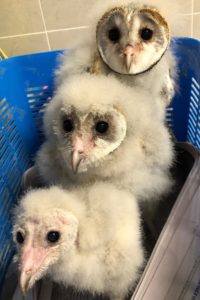
The Easter Barn Owl (Tyto javanica) is quite a common night bird around the Roma district and throughout much of Queensland. To give it it’s full name, it’s the Eastern Barn Owl, which distinguishes it from very similar and closely-related forms in other parts of the world.
You are most likely to see this bird while driving at night. It often perches on fence posts or roadside guide posts while hunting its favourite prey, rats and mice. The Barn Owl also catches small insect-eating bats (especially if the owl roosts in or near a cave) and even large insects, but they seem to do best on a diet of small mammals. During the day Barn Owls are usually well hidden in a tree hollow, cave or farm shed. They are a beautiful bird when well seen, showing their white heart-shaped face and underparts which contrast with the light brown, silvery-grey speckled, back. Seen in the headlights of your car they often just appear a ghostly white. Their voice, a harsh screeching hiss, is quite a common sound on quiet nights in the bush or on farms.
In this part of the world the Barn Owl commonly starts nesting in autumn, with young hatching and growing over winter. The number of eggs laid appears to depend on how well nourished the female bird is and ranges from two to nine.
If food remains plentiful, as in a House Mouse plague, many of the hatched young will survive. When times are harder it may only be the first born and therefore stronger youngster that makes it to maturity by out-competing his smaller siblings for the food provided by the parents. The young beg noisily for food and the sound of a nest full of young carries far on still winter nights.
Meryl’s Rescue Barn Owls
 Recently, Meryl became the proud carer of three young owls rescued from a hollow in a fallen tree. Initially the oldest bird was much bigger than its two siblings. It seems that the parents were only catching enough food (mice) to meet the needs of the eldest. Thanks to Meryl’s supply of pet-shop mice all three are doing well with the two smaller birds catching up fast. The photo shows the three of them, with the youngest at the front and the eldest at the back.
Recently, Meryl became the proud carer of three young owls rescued from a hollow in a fallen tree. Initially the oldest bird was much bigger than its two siblings. It seems that the parents were only catching enough food (mice) to meet the needs of the eldest. Thanks to Meryl’s supply of pet-shop mice all three are doing well with the two smaller birds catching up fast. The photo shows the three of them, with the youngest at the front and the eldest at the back.
This picture is a good one for showing the development of the “face”. The youngest bird is still covered in down and has yet to show any facial feathering. The long beak is obvious. The next in line shows the beginnings of the face as the feathers grow. The eldest, at the back, has already got a well-developed face. Notice how much shorter its beak appears to be as the facial feathers grow out and cover the base of the beak. When you see an adult Barn Owl you may think it has quite a small beak, but in reality, it’s mostly hidden from view.
The distinctive facial disc is made up of many quite stiff feathers. It serves a very interesting purpose. As Barn Owls hunt by night, eyesight isn’t much help – they rely on their extraordinarily good hearing to find prey. The disc helps in directing sound to their ears, rather like the cone around a directional microphone. Barn Owls can detect and catch mice in total darkness by homing in on the small sounds they make as they move. Amazing birds!
If you come across a sick, injured or orphaned wildlife, please contact the Maranoa Wildife Caring & Education Centre. MWCEC is a charitable organisation, that is run by volunteers, funded by donations and grants and was formed to provide rescue and rehabilitation services to the local native wildlife in the Maranoa area. It also aims to provide training to wildlife care volunteers and promote protection of our native fauna and biodiversity.

